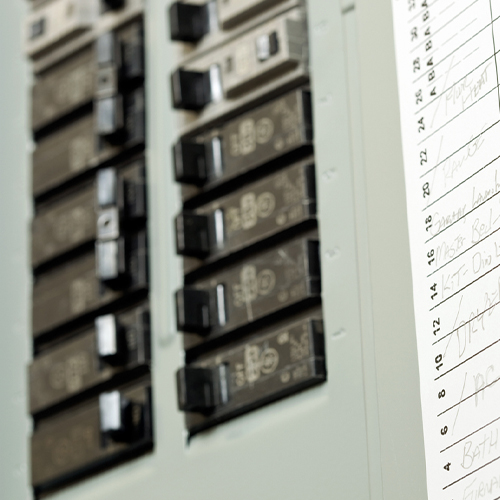Why Homeowners Call Rhema
Common Questions About Circuit Breaker Installation
A circuit breaker acts as a safety device for your electrical system. It constantly monitors the flow of electricity and shuts off power when it detects a problem, such as a short circuit, overload, or ground fault.
This “tripping” prevents overheating, fire hazards, and equipment damage. After the issue is resolved, the breaker can be manually reset to restore power. It’s one of the most important components protecting your home from electrical risk.
You might need a breaker replaced or repaired if:
- The same breaker trips repeatedly without a heavy load
- It trips immediately after resetting
- There are signs of heat, like a warm breaker or burning smell
- You hear crackling or buzzing inside the panel
- The breaker is visibly damaged, rusted, or won’t stay reset
Some of these symptoms could point to a deeper problem, such as loose wiring or panel damage. We recommend having a licensed electrician inspect the issue promptly.
No, circuit breaker replacement is not safe for DIY. Even when the main breaker is off, parts of the panel may still carry live voltage. One mistake can cause electrical shock, fires, or system-wide damage.
Our licensed electricians follow strict safety protocols and make sure all replacements are performed up to code, giving you peace of mind and long-term reliability.
Yes, it matters a great deal. A 220-volt (also referred to as a 240-volt) breaker uses two hot wires from opposite legs of your service panel, each carrying 120 volts. These must be connected to the correct terminals on the breaker.
If the wiring is incorrect, it could cause the breaker to malfunction, damage your appliances, or create serious safety hazards. That’s why 220 or 240v circuit breaker installation should always be handled by a trained professional.
When you hire Rhema Electric for circuit breaker replacement, here’s what to expect:
- Diagnosis: We start by inspecting the panel and identifying the faulty breaker or root issue.
- Power Shutdown: The power to that circuit (or, if needed, the full panel) is safely turned off.
- Removal: The old breaker is carefully detached from the bus bar and wiring.
- Installation: A new, properly sized breaker is installed and securely connected.
- Testing: We restore power and test the new breaker to confirm safe operation.
- Code Check: We make sure the rest of your panel is safe and compliant with current codes.
This service helps reduce fire risk, prevent equipment damage, and give you confidence in your home’s power system.

